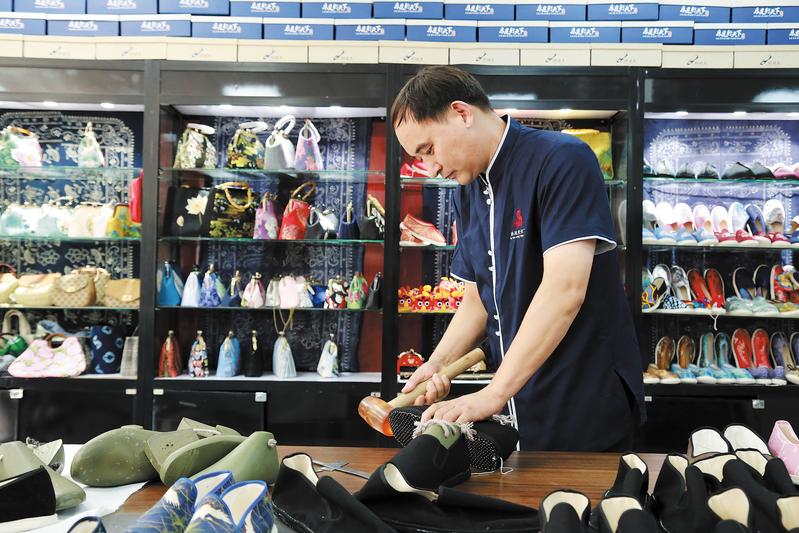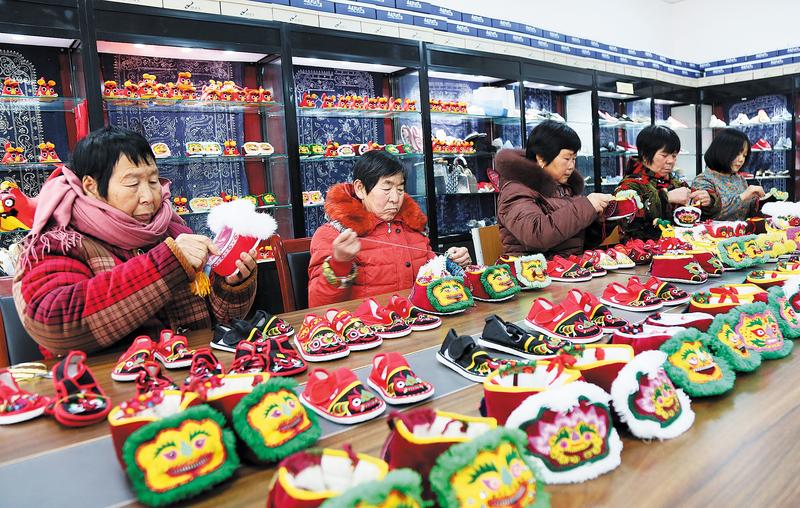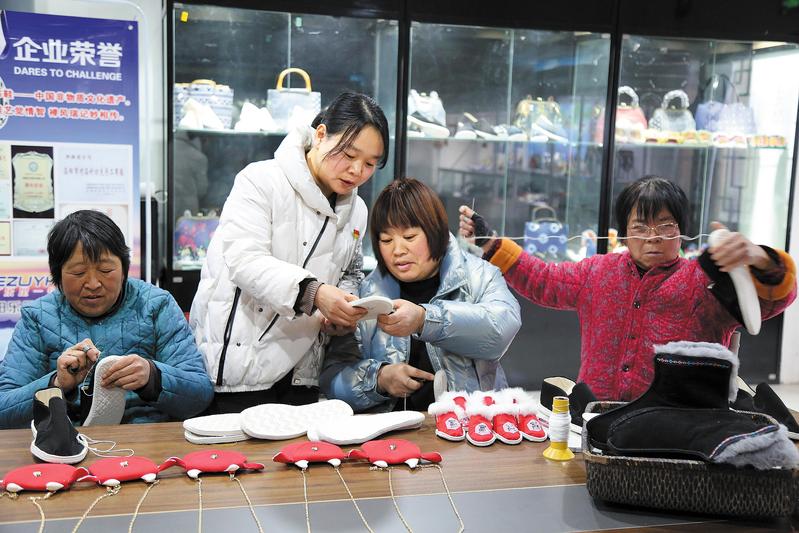Cloth shoes help entrepreneur put his best foot forward, Yang Feiyue reports.
 Duan Yuguo molds cloth shoes with a hammer at his workshop in Gaozhuang village, Ruyang county, Henan province. (PHOTO PROVIDED TO CHINA DAILY)
Duan Yuguo molds cloth shoes with a hammer at his workshop in Gaozhuang village, Ruyang county, Henan province. (PHOTO PROVIDED TO CHINA DAILY)
Cloth shoes with "thousand-layered soles", called qiancengdi buxie in Mandarin, have long been deemed by the Chinese, especially the older generation, as a sign of their mother's love. The shoe certainly is a work of devotion. Thousands of stitches have to be applied to fashion them out of layers of paper-thin cloth.
Although modern shoes made with high-tech materials have claimed center stage, traditional handmade cloth shoes have managed to survive the test of time and hang onto a niche market.
When sewing the shoe top, if the stitching is not straight, even by an inch, it can affect the appearance of the shoe and make it look less attractive. You just have to stick to the methods that work and practice them over and again, and things will turn out fine.
Duan Yuguo, inheritor of cloth shoemaking
Duan Yuguo has tapped into the desire of those who seek comfort the old fashioned way and turned his family shoemaking heritage into a growing business that brings benefits beyond his family walls.
A group of women laid siege to Duan in early February, listening attentively as he demonstrated tips on how to make a special kind of shoe that has been passed down through his family for generations.
After Duan finished, he got them to practice. At his workshop in Gaozhuang village, Ruyang county, Luoyang, Central China's Henan province, he taught them to pound the soles, trim rough edges and shape the shoes.
During the process, Duan watched them closely, giving instructions to ensure their operations were on the right track.
"When sewing the shoe top, if the stitching is not straight, even by an inch, it can affect the appearance of the shoe and make it look less attractive," says Duan, who is in his 40s. "You just have to stick to the methods that work and practice them over and again, and things will turn out fine."
An array of simple but plush cloth shoes featuring diverse elements — including refined Suzhou-style embroidery, images of tiger heads and fashionable patterns — take up considerable space in Duan's workshop, making it look like a shoe museum.
"The shoes are crafted entirely from cotton and linen fabrics, using a composite made of flour and water as glue, without any chemical additives," Duan says. "This gives the shoes a breathable quality and makes them comfortable to wear."
 Local village women make tiger-head cloth shoes at Duan's workshop. (PHOTO PROVIDED TO CHINA DAILY)
Local village women make tiger-head cloth shoes at Duan's workshop. (PHOTO PROVIDED TO CHINA DAILY)
Imperial hue
Although Duan's shoes may not have a flashy appearance, they are indeed steeped in a rich history and carry strong cultural significance, Duan explains.
As early as the Emperor Qianlong's reign (1736-96) of the Qing Dynasty (1644-1911), predecessors of Duan's family made cloth shoes for court officials with their superb sewing and needlework skills.
In the 19th century, earlier generations of his family opened shoe stores in Ruyang and places as far away as Beijing, and drew in a large number of apprentices in Henan.
However, the booming cloth shoe family business hit a low ebb after social turmoil before the founding of the People's Republic of China in 1949 and failed to keep up with the times afterward.
"It broke off from the time of my father, who didn't carry on the family tradition," Duan says.
Fortunately, his mother Shi Xizhi managed to learn the craft from his grandfather, but she mainly made the shoes for domestic use.
"I watched her making the shoes in childhood and she let me play with the scraps of cloth," he recalls. "I felt curious when those pieces of cloth were turned into the shoes I wore."
These early memories were fresh in Duan's mind when his mother suggested reviving the family tradition in 2008. At the time, he was at a loss as to his future career, and "was doing odd jobs away from home and couldn't find a direction", he says.
After the conversation, Duan came back and started to learn his family's shoemaking skills from his mother.
Making a cloth shoe involves more than 100 steps, each of which makes or breaks the final outcome.
Described in broad strokes, one first needs to paint the shoe sole onto cloth before cutting it out with a pair of scissors. The step will be repeated many times to acquire multiple layers of the cloth in the shape of the sole.
Then paste is applied on the cloth strips to bind edges of the layers of cloth to form the foundation of the sole. Cotton will then be padded in and sewn onto the surface with a cloth cover.
"That is when the sole is finished," Duan says, adding that crafting the sole is the most important step.
After that, the sole is stitched together with the upper cloth.
Finishing touches include stuffing hot rubber in the shape of different foot parts in the shoe to fix the structure and fine-tune the design.
"All is done by hand and it takes about five to six days to finish a pair of cloth shoes," Duan says, noting that at least 2,100 stitches will be applied to a pair.
However, it wasn't plain sailing after he inherited the family shoe skills.
"There was still a long way to go before I could turn those shoes into commodity for the market. After all, they had been mostly made for our own family use," he says.
 Duan's wife (left) discusses cloth shoe sole-making with a woman. (PHOTO PROVIDED TO CHINA DAILY)
Duan's wife (left) discusses cloth shoe sole-making with a woman. (PHOTO PROVIDED TO CHINA DAILY)
A modern twist
Duan spent the following three years visiting shoe experts in Shanghai municipality, Hubei, Shanxi and Zhejiang provinces and learning various techniques to complement his own.
He combed through more than 80 shoemaking techniques and studied and compared them before making changes to combine their strength and ensure a more comfortable wearing experience.
First, he needed to upgrade the look of the shoes to cater to the needs of modern consumers. "After all, shoes in the past were made out of old rags and applied way more stitches than what is necessary for today's circumstances," he says. "It resulted in toughness at the cost of comfort."
After constant experimenting, he found the golden mean.
"Taking size 40 shoes as an example, the standard for the shoe top is 95 to 96 stitches. It will not be practical nor aesthetically pleasing if the stitches are too dense or sparse," he says.
He also spent great effort searching for raw materials that were hard to come by in his rural home long before e-commerce was available.
He had to travel far and wide to find such materials as stretchable fabric and eyelets (usually reinforced with metal rings as a way to thread cords through) in Fujian, Zhejiang and Shanxi provinces.
"It was really an ordeal, but fortunately I didn't give up," he says.
His work eventually garnered the interest of several shoe plant owners, who entrusted him with big orders.
In 2012, Duan established his cloth shoemaking company in Gaozhuang village. He made a point of keeping essential traditional methods while innovatively integrating embroidery and other elements.
As a result, he developed a series of products that cater to different customers, ranging from children to the elderly, and his exquisite craftsmanship and rich style earned his products interest from the high-end market.
"Many of my customers are scholars and college professors, who pursue comfort," he says, adding that a considerable number of these customers have opted for his shoes out of a sense of nostalgia.
Duan's wife Chen Na made a tough decision and quit her teaching job to help him. "The orders were piling up and he was working around the clock. I felt impelled to help," Chen says.
Now she's also engaged in the handicraft and has even branched out to make bags with similar craftsmanship.
In 2017, the Duan family's cloth shoe craftsmanship was named an intangible cultural heritage of Ruyang county and a time-honored brand. At the same time, it was rated among the most popular tourism products in Henan's Luoyang city by the tourism and consumer departments.
 Visitors check cloth shoes at Duan's booth at an intangible cultural heritage exhibition held by Henan's provincial culture and tourism department and the Zhoukou city government. (PHOTO PROVIDED TO CHINA DAILY)
Visitors check cloth shoes at Duan's booth at an intangible cultural heritage exhibition held by Henan's provincial culture and tourism department and the Zhoukou city government. (PHOTO PROVIDED TO CHINA DAILY)
Benefiting more
In June 2019, the Ruyang county government pooled together 3.6 million yuan ($517,320) for poverty alleviation and launched a cloth-shoe cultural and industrial park. Duan then set up a center for poverty alleviation in the park and was charged with the responsibility of helping villagers increase income by making cloth shoes.
He says he was more than ready to oblige.
"I have a strong personal interest in handmade cloth shoes and would love to share the art with more people," he says. "I also feel the need to pass on my inheritance."
To his surprise, many of the households in the area used to have a tradition of making cloth shoes and did not require much training in terms of technical skills. "With some guidance and standardization, they can produce high-quality products," he says.
To date, he has reached out to more than 1,000 households in the surrounding villages.
Zhao Rulai from Gaozhuang village learned to make a pair of shoe soles in a day after receiving Duan's training. The skill gives her an extra income of more than 1,500 yuan a month.
"It was very nice of him to enable us old women to make money at home," says Zhao, now in her 60s. "I had to return the favor with meticulous work."
With the expanded production capacity, annual sales of Duan-style cloth shoes reached 10,000 pairs, retrieving a value of 2.4 million yuan.
In 2020, Duan-style cloth shoes were named an intangible cultural heritage of Luoyang and his workshop started a partnership with the intangible cultural heritage study and training program run by the Ministry of Culture and Tourism.
Together they have refined the cloth-shoe production process through greater division of labor. Some workers are responsible for repairing the soles of the shoes, while others embroider the shoe tops.
"This arrangement not only saves business costs, but also provides a convenient way for local villagers to earn additional income during their spare time," he says.
Recently, Duan's workshop was selected as one of 66 exemplary cases supporting rural vitalization by the Ministry of Culture and Tourism, the Ministry of Human Resources and Social Security and the National Rural Revitalization Administration.
The accolades have given Duan more faith and enthusiasm to carry on his cause.
Contact the writer at yangfeiyue@chinadaily.com.cn


